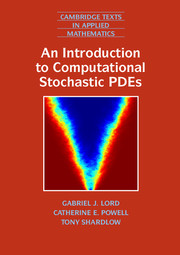Book contents
1 - Linear Analysis
Published online by Cambridge University Press: 05 July 2014
Summary
This chapter introduces theoretical tools for studying stochastic differential equations in later chapters. §1.1 and §1.2 review Banach and Hilbert spaces, the mathematical structures given to sets of random variables and the natural home for solutions of differential equations. §1.3 reviews the theory of linear operators, especially the spectral theory of compact and symmetric operators, and §1.4 reviews Fourier analysis.
Banach spaces Cr and LP
Banach and Hilbert spaces are fundamental to the analysis of diferential equations and random processes. This section treats Banach spaces, reviewing first the notions of norm, convergence, and completeness before giving Definition 1.7 of a Banach space. We assume readers are familiar with real and complex vector spaces.
Definition 1.1 (norm) A norm ∥·∥ is a function from a real (respectively, complex) vector space X to ℝ+ such that
(i) ∥u∥ = 0 if and only if u = 0,
(ii) ∥ λu∥ = |λ| ∥u∥ for all u ∈ X and λ ∈ ℝ (resp., ℂ), and
(iii) ∥u + v∥ ≤ ∥u∥ + ∥v∥ for all u, v ∈ X (triangle inequality).
A normed vector space (X, ∥·∥) is a vector space X with a norm ∥·∥. If only conditions (ii) and (iii) hold, ∥·∥ is called a semi-norm and denoted |·|x.
- Type
- Chapter
- Information
- An Introduction to Computational Stochastic PDEs , pp. 1 - 39Publisher: Cambridge University PressPrint publication year: 2014

